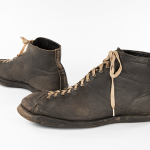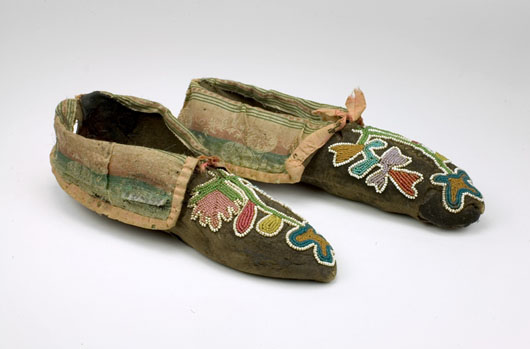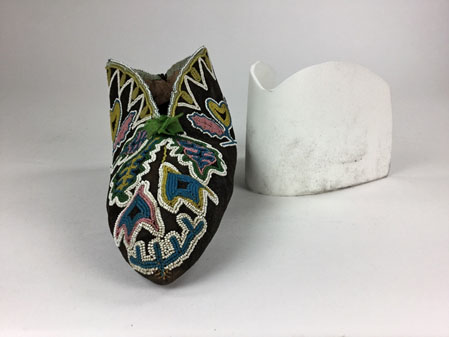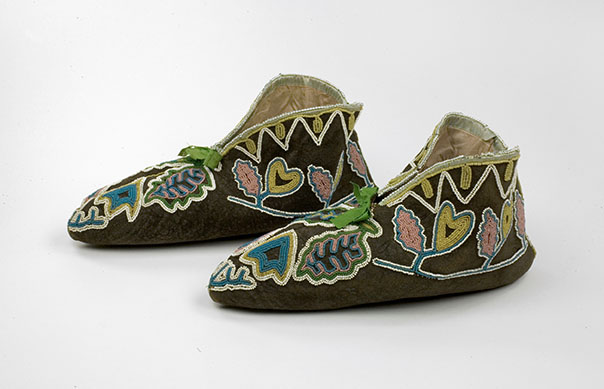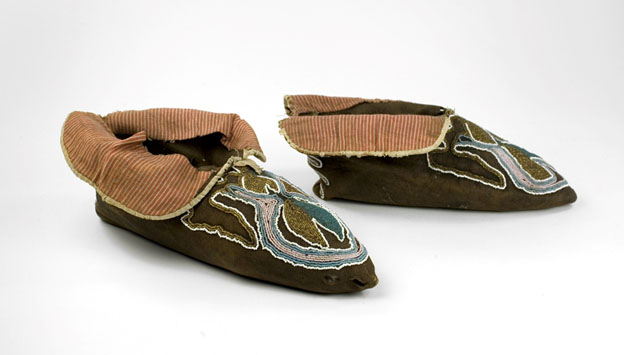People always ask me if there are any artefacts in the BSM collection that make me trepidatious when handling. The answer is: moccasins made with this rich dark brown colour of deerskin, achieved by immersing the cleaned skin in a different types of natural dyes. Each artist has their own method depending on regionally available resources. There are a variety of materials used ranging from black walnut, the inner bark of the butternut tree or a rich black mud. The finished colour creates a lovely contrasting canvas that shows off the artist’s beautiful beadwork designs.
Cherokee, ca. 1825: Support patches are inserted in the toe of the moccasin in the back of the picture & in the heels of both.
These aging dyed skins, some as old as 180 years in the moccasins shown, can be notoriously fragile and challenging to stabilize. The skin becomes friable; its powdering surface easily comes off on one’s gloves when handled. The weight of the beadwork pulls against the deerskin if it is unsupported, creating tears along these areas of stress. The structural stability of the moccasins is so delicate that the internal supports need to be soft enough that they can be easily manipulated for removal, yet provide resistance to keep its shape without having any edges that will cut through the skin.
Cherokee, ca. 1840: Fine, powdery fibres of deerskin cover the foam used internally to support the sides of the moccasin while in storage.
When these moccasins arrived at the museum, one was missing a bow. The replacement bow was made from a bonnet ribbon, sourced from a friend, of the period that was the exact colour.
Another consideration is the supports need to be sympathetic in appearance so they are not visually arresting, detracting from the artistry of the design when the moccasins are on display. Removal needs to be uncomplicated to facilitate internal examination of the structure.
Lenape, ca 1840 – 1880: The cotton stitches that once attached the bottom edge of the striped fabric have disintegrated. The skin is far too fragile to reattach this lining.
The unknown conditions, prior to acquisition, of preexisting storage and display have exacerbated the inherent fragility. All three pairs of moccasins pictured in this blog required conservation intervention when they arrived at the museum. The powdery skin makes it challenging to adhere infills for holes and supports for tears. Several of the previous conservation interventions applied with adhesives had failed. These were replaced with lightweight Reemay, a nonwoven spunbonded polyester fabric, dyed to match the colour of the deerskin. These repairs were nestled against the holes and tears, held in place with the soft internal supports.
At the museum we try to reduce handling these incredibly fragile moccasins as much as possible. Tailor made storage containers are constructed from museum grade materials, with Mylar (a polyester film) ‘windows’ for viewing. For each pair, one moccasin faces forward, its mate faces the opposite direction. This allows one to see the complex beadwork, while eliminating unnecessary touching.


